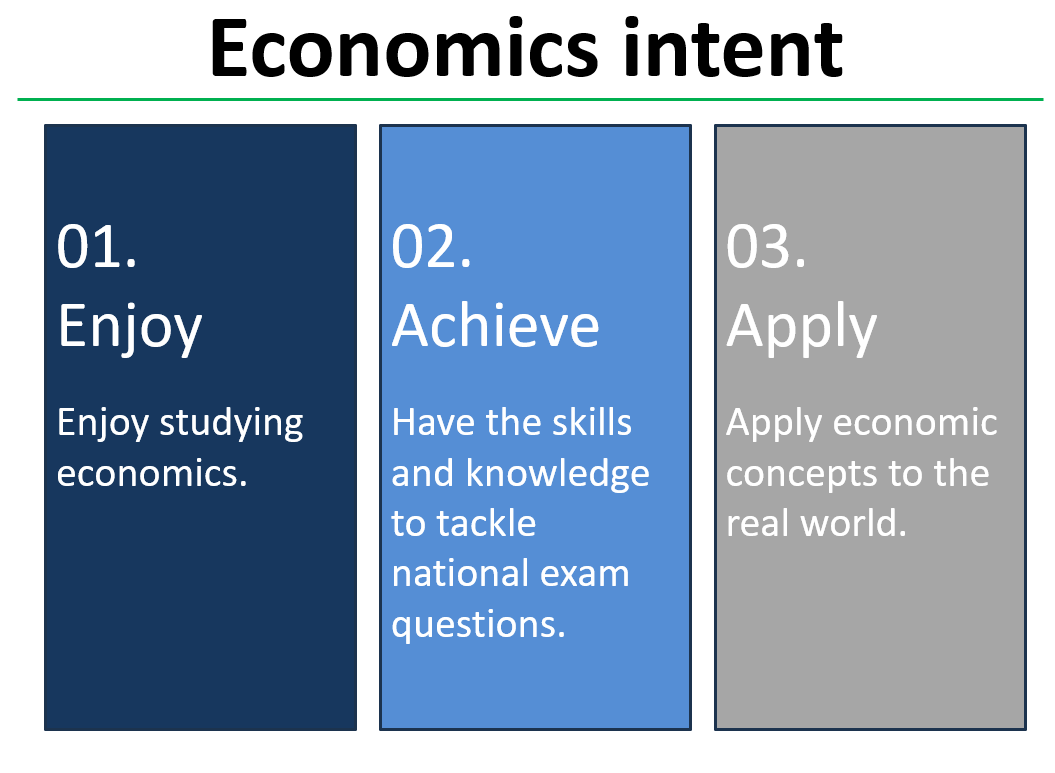Economics
Economics A level

The A-level economics learning journey.
Why do students embark on an A-level economics learning journey?
The subject of economics exists to explore solutions to one basic problem: societies have unlimited needs and wants, but limited resources. This problem creates the need for societies to choose how they allocate their scarce resources. Examples of choices include:
- How should healthcare/education/public transport be provided?
- How should governments tax and/or spend to control inflation/reduce unemployment/drive economic growth?
Students embarking on an A-level economics learning journey explore the reasons for, and the impact of, those difficult choices.
How is the A-level economics learning journey structured?
The learning journey is split into two main sections: (1) micro-economics and (2) macro-economics. The journey for each section begins at the same time – the start of the course. Both sections are then taught in parallel. Students will have one teacher for each section.
However, as the learning journey through A-level economics evolves, students will appreciate that micro-economics and macro-economics are not entirely distinct areas of study. For example, micro-economic principles often provide fundamental insights into understanding aspects of the macro-economy. Similarly, economic issues and problems often contain both a micro-economic and macro-economic dimension.
The content for each section is summarised below.
1. The microeconomic section introduces students to the issues facing the constituent parts of an economy (individuals, businesses, markets and governments). The issues include:
- The choice between using governments or markets to provide goods and services.
- The rational/irrational economic behaviour of individuals and consumers.
- The distribution of wealth and income in the UK.
2. The macroeconomic section explores issues affecting the economy as a whole. The issues include:
- Inflation.
- Unemployment.
- Taxation and government spending.
How are students assessed at the end of the A-level economics journey?
Students take three exam papers at the end of the course.
- Paper 1 assesses micro-economics
- Paper 2 assesses macro-economics
- Paper 3 assesses a combination of micro-economic/macro-economic content.
Students need a blend of knowledge and skills to perform well in the final exams – these are taught in parallel throughout the course.
What will students be able to do by the end of their A-level economics learning journey?
By the end of a two-year economics A-level course, students should be able to:
- apply economic theory to support analysis of current economic problems and issues.
- appreciate the interrelationships between micro-economics and macro-economics.
- relate economic concepts to the world around them – locally, nationally and globally.
- understand and analyse data.
- think critically about issues and make informed decisions.
- make relevant calculations from economic data.
- acquire competence in quantitative skills that are relevant to the subject content. Examples of relevant quantitative skills include:
- interpreting data presented in the form of index numbers.
- constructing and using graphs.
- applying statistical measures such as the mean, median and relevant quantiles.
- be familiar with the various types of statistical and other data which are commonly used by economists.
- appreciate the importance of using qualitative and quantitative evidence when evaluating.
- structure essays that explore economic issues and policies.
What do students identify as the main benefits of undertaking an A-level economics learning journey?
- It provides real life skills, such as data analysis, critical thinking and problem solving. These skills are highly valued in many careers such as law, finance and consulting.
- An understanding of the economy helps students to be more informed about local, national and global issues.
- The content has excellent crossover with other academic subjects, such as geography, politics, maths, psychology and business.
- It is enjoyable.
Curriculum map Year 12 & 13 Macro Economics
| Macroeconomics Curriculum Map | |
| Y12 term 1 | Macro: Measuring Macroeconomic Performance |
| Y12 term 2 | Macro: Factors Impacting Macroeconomic Performance |
| Y12 term 3 | Macro: Factors Impacting Macroeconomic Performance |
| Y12 term 4 | Macro: Policies to influence Macroeconomic Performance |
| Y12 term 5 | Macro: Policies to influence Macroeconomic Performance |
| Y12 term 6 | Macro: Further impacts on macreoeconomic performance |
| Y13 term 1 | Macro: International Economics |
| Y13 term 2 | Macro: International Economics |
| Y13 term 3 | Macro: Financial Markets and Financial Regulation |
| Y13 term 4 | Macro: Financial Markets and Financial Regulation |
| Y13 term 5 | Macro: Revision and Exam Technique |
Curriculum map Year 12 Micro Economics
|
Y12 Autumn 1 |
Y12 Autumn 2 |
Y12 Spring 1 |
Y12 Spring 2 |
Y12 Summer 1 |
Y12 Summer 2 |
|---|---|---|---|---|---|
|
4.1.1 - Economic methodology and the economic problem
4.1.3 - Price determination in a competitive market (part 1)
|
4.1.3 - Price determination in a competitive market (part 2)
|
4.1.8 - The market mechanism, market failure and government intervention in markets (part 1)
|
4.1.8 - The market mechanism, market failure and government intervention in markets (part 2)
|
4.1.2 - Individual economic decision-making
|
Revision / exam technique
Mock exams |
Curriculum map Year 13 Micro Economics
|
Y13 Autumn 1 |
Y13 Autumn 2 |
Y13 Spring 1 |
Y13 Spring 2 |
Y13 Summer 1 |
Y13 Summer 2 |
|---|---|---|---|---|---|
|
4.1.4 - Production, costs and revenue
4.1.5 - Perfect competition, imperfectly competitive markets and monopoly (part 1)
|
4.1.5 - Perfect competition, imperfectly competitive markets and monopoly (part 2)
|
4.1.8 - The market mechanism, market failure and government intervention in markets (part 3)
|
4.1.7 - The distribution of income and wealth: poverty and inequality
|
Revision / exam technique
Public exams |
Revision / exam technique
Public exams |
